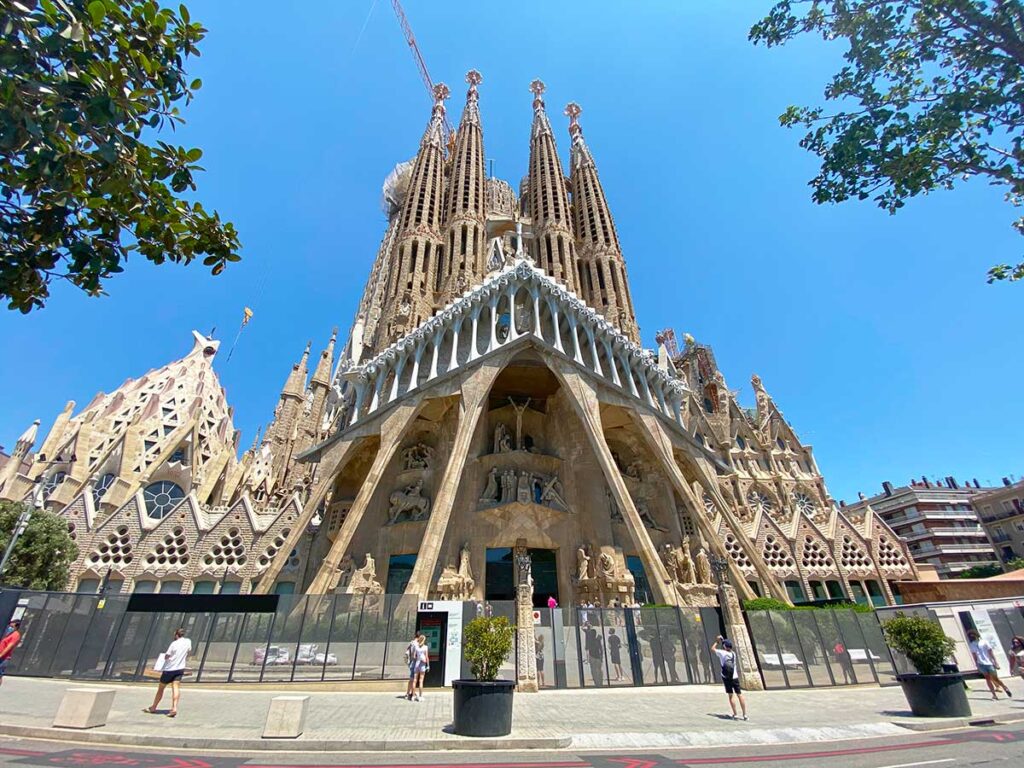
The last time I went to Barcelona I stayed for two weeks. The time before that? Two months. But on my most recent trip I only had one day in Barcelona, which really made me think about the best ways to spend a limited amount of time in the Catalan capital. I had become accustomed to taking Barcelona at a slower pace, complete with siestas, happy hours and leisurely lunches, but suddenly I needed to make every minute count.
If I was a first-time visitor with only one day in Barcelona, this is what I would want to see and do. It includes a good mix of Gaudi’s showstopping architecture and other facets of what makes Barcelona so special, like it’s ancient seafaring history and its contemporary Catalan cuisine and culture.
In order to follow this one-day Barcelona itinerary, you’ll need to plan well in advance. Many of Barcelona’s top attractions sell out of tickets every day, or have extremely limited availability on the day-of, so you need to reserve your tickets as soon as you know your travel dates.
![]()
8:00 AM – Spanish Breakfast
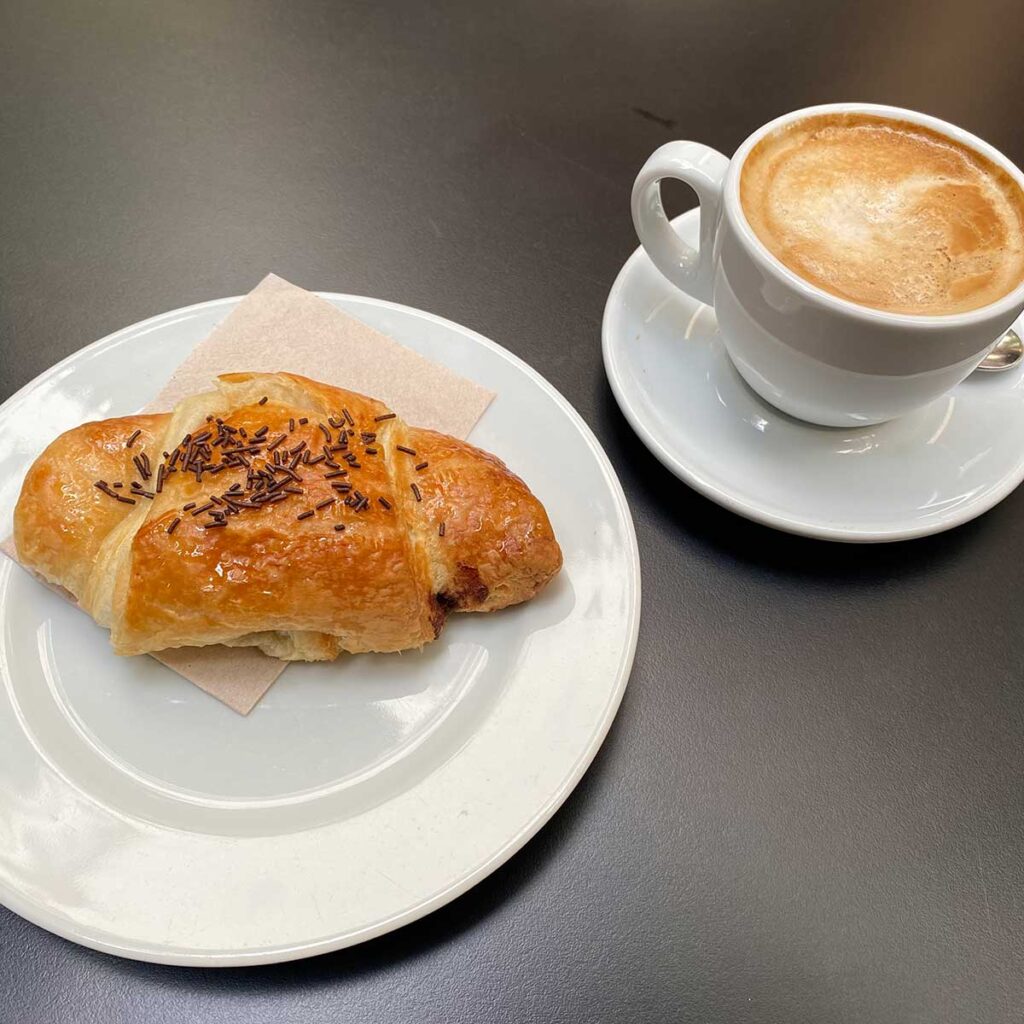
With only one day in Barcelona you’ll want to get an early start. Plan your morning so that you’re ready to leave your hotel (or head to the breakfast buffet) at 8:00 am, and have a quick Spanish breakfast. Eat like the locals and have one of the following:
- Bread with butter and jam or cheese
- Toast with grated tomatoes and olive oil (pan amb tomquet)
- A croissant or other sweet pastry
Most Spaniards will have coffee with their light breakfast, and maybe a glass of orange juice too. Take the bottle of water from your hotel room to drink during the day.
9:00 AM or 9:30 AM – Parc Guell
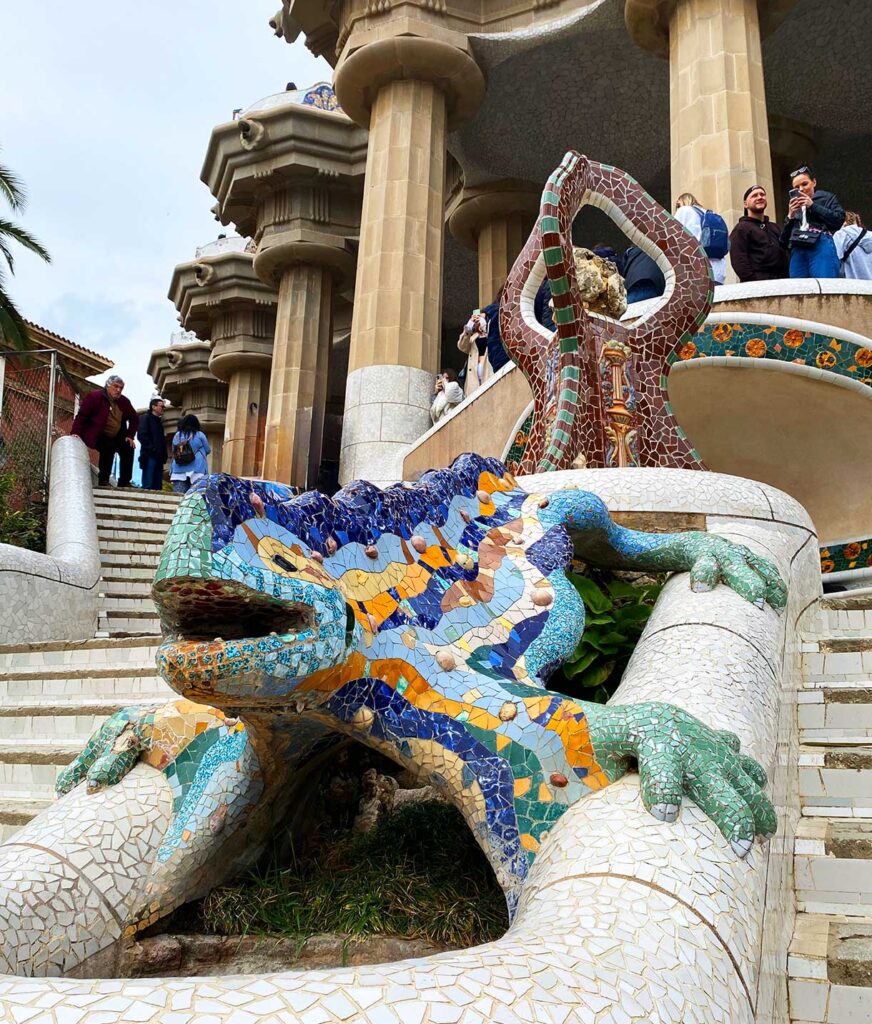
Depending on the season, Parc Guell opens its doors to tourists at either 9:00 am or 9:30 am. It’s essential to order your tickets online well in advance – I recommend using the official site.
You want to start here because this is the highest point that you’ll be visiting in the city, and it’s all downhill from here. The park’s website has three different recommended walking routes, depending on your entrance.
Architect Anton Gaudi envisioned Parc Guell as an exclusive community of upscale homes developed around an aesthetic natural park. However, the unattractive location on a barren hill with few transportation connections, combined with a convoluted lease system that was deemed too high-risk for most potential buyers, meant that only two houses were ever built, and they were occupied by Gaudi himself and the Count that the park is named after.
Instead, the park was converted to a municipal garden and opened to the public. For most of the park’s history admission was free, but tickets had to be introduced in 2013 to cope with the rising number of international tourists visiting Barcelona.
Some of the highlights in Parc Guell include:
- The Porter’s House – There are two gingerbread-like houses at the entrance to Parc Guell. These were intended to be a home for the concierge (or caretaker) who would look after the community, and a reception area for visitors who were coming to the housing development to meet a resident.
- The Monumental Staircase – Two flights of decorated stairs connect the entrance to the upper levels of the park. This is where you’ll find the famous mosaic salamander, who is nicknamed “The Dragon”.
- The Hypostyle Room – At the top of the stairs a large area is sheltered by a series of terracotta columns. Gaudi had intended for this pavilion to host a weekly market for residents.
- Nature Square – Above the Hypostyle Room, Nature Square offers panoramic views of Barcelona. The edges of the square are lined with an undulating tile bench that evokes the image of a sea serpent or other mythical creature. The bench was not designed by Gaudi, but rather by his collaborator Josep M. Jujol.
- Natural Areas – On either side of Nature Square there are natural green areas with local plants and some further decorations (similar to those seen around the main square).
- Gaudi House Museum – A separate ticket is required to enter the Gaudi House Museum, in the pink house located to the northeast of Nature Square. Some of the furniture and art that Gaudi owned is still inside the house, along with exhibits about the architect’s life and works. I recommend skipping it if you only have one day in Barcelona.
10:45 AM – Depart Parc Guell for Sagrada Familia
After spending about 90 minutes (mas o menos) in Parc Guell, it’s now time to head to another one of Gaudi’s masterpieces. The Sagrada Familia is only about 2.5 kilometers downhill from the park (towards the ocean and city center) but since you’re pressed for time, I suggest taking a taxi or Uber as it will get you there in less than ten minutes.
11:00 AM – Sagrada Familia Tour + Optional Tower Visit

The Sagrada Familia has been under construction for more than 140 years, but you are going to power through it in just over one hour today. Go team!
Like Parc Guell, this is one attraction you will need to reserve your tickets on the official site in advance. There are limited entries to the basilica’s two towers (one on the Nativity Facade and the other on the Passion Facade), and they sell out in advance. As I’m writing this, the towers are completely sold out for the next four days, and morning slots are completely sold out for the next ten days. Again, book in advance!
Of the two towers, the Nativity Tower is thought to be preferable for a visit (and you’ll notice it usually sells out first). I prefer the view from this tower, and there is more space to explore outside. With both towers, you use the elevator to go up and then the original spiral staircase to go down, so wear sturdy shoes and avoid any clothes that are a tripping hazard.
If you don’t plan to go up the towers, there is a bit more flexibility in ticketing for the Sagrada Familia. There are no tickets left for today or tomorrow (at press time), but there are a few late-morning entrances three days from now, and more as I look into next week. Again, though, don’t leave your Sagrada Familia tickets until the last minute!
Most visits to the Sagrada Familia start with a walk around the church’s exterior, where you can see the famous facade and the detail on the towers from ground level. Then, you’ll head inside the luminous church interior, where towering columns stand for the forest’s trees and stained glass windows let the natural sunlight pour in.
The lower level of the church also features a museum dedicated to Gaudi and his vision for the building. Some of his original plans have been preserved here, along with photographs of him leading dignitaries through the construction zone. Look down into the crypt and you can also see Gaudi’s final resting place.
12:30 – Depart for Plaza de Catalunya
Using the purple metro line (Line #2) you can travel from the Sagrada Familia to Barcelona’s city center in fifteen minutes. Take the train towards Paralel and get off after four stops at the station called Passeig de Gracia. From here, follow the signs to Placa de Catalunya.
12:45 – Lunch Time!
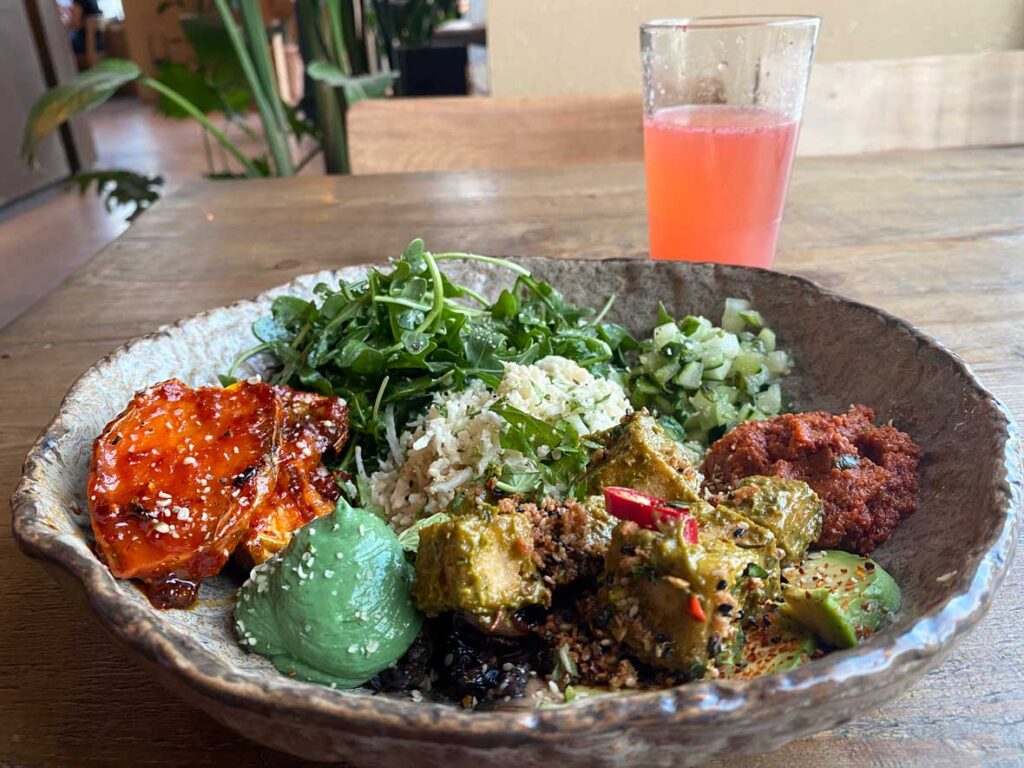
Lunch is one of my favorite meals in Spain, and I think a quintessentially Barcelona experience is to enjoy a leisurely multi-course lunch mid-day. Many of the restaurants directly on Plaza de Catalunya are tourist traps, but there are some hidden gems within an easy five-minute walk:
- Teresa Carles – My #1 recommendation for lunch near Plaza de Catalunya. This restaurant is vegetarian, but omnivores won’t be disappointed by the weekday set price lunch menu that features several options for each course and changes weekly based on what local produce is in season. At press time, a three-course lunch with appetizer, main course and dessert is €15 – I always order a glass of house wine too. To see the menu options for each week of the month, click here and scroll down to “Platos del Dia” – if you like what you see, book online here.
- Els 4 Gats – The lunch menu here probably won’t be vegetarian-friendly, but if you’re looking for a unique lunch experience in Barcelona come to Els Quatre Gats (“The Four Cats”) a restaurant dating back more than 130 years, where many of Barcelona’s famous Modernist artists and architects used to gather to share ideas. You can book your table online at their website.
- Honest Greens – This Spanish salad chain is starting to expand internationally, and for good reason. They make delicious salads, market plates and bowls (shown above) that can be customized with the protein of your choice (including vegetarian and vegan options). I always order a big salad and a glass to fill with their fruit- and herb-infused water.
- La Plaça Gastro Mercat (Inside El Corte Ingles) – If you are spending one day in Barcelona with kids or having to cater to wildly different appetites, the top-floor cafeteria in the El Corte Ingles department store in a great option. This full-service buffet-style restaurant features popular dishes from all over Spain and sweeping views of the city beneath you. Expect to find salads, sandwiches, tapas, paella, meat, seafood and more.
Looking for more Spain travel tips?
Follow Fearless Female Travels on Facebook for actually-useful tips on traveling in Spain, conversations with other female travelers, and more! (No annoying emails – I promise!)
2:00 – Self-Guided Walking Tour of Historic Barcelona
You’ve already seen two of Barcelona’s Modernist masterpieces, so now it’s time to go back in time even further, to medieval and Renaissance Barcelona. The most historic districts of Barcelona are right in front of you, between your lunch restaurant and the Mediterranean Sea.
Barcelona is an extremely walkable city, which you’ll quickly realize as you explore the historic city center. Attractions are close to one another, and the historic heart of the city is almost perfectly flat. This self-guided walking tour covers an area less than one kilometer long and 500 meters wide, so it should be safe and comfortable for most travelers.
Starting from Placa de Catanlunya, you can explore the following attractions by foot, navigating via Google Maps or a paper map (available at the Tourist Information office right on Plaza de Catalunya).
(If you’re low on cellular data, follow my guide to downloading offline Google Maps before your trip beings.)
1. La Rambla
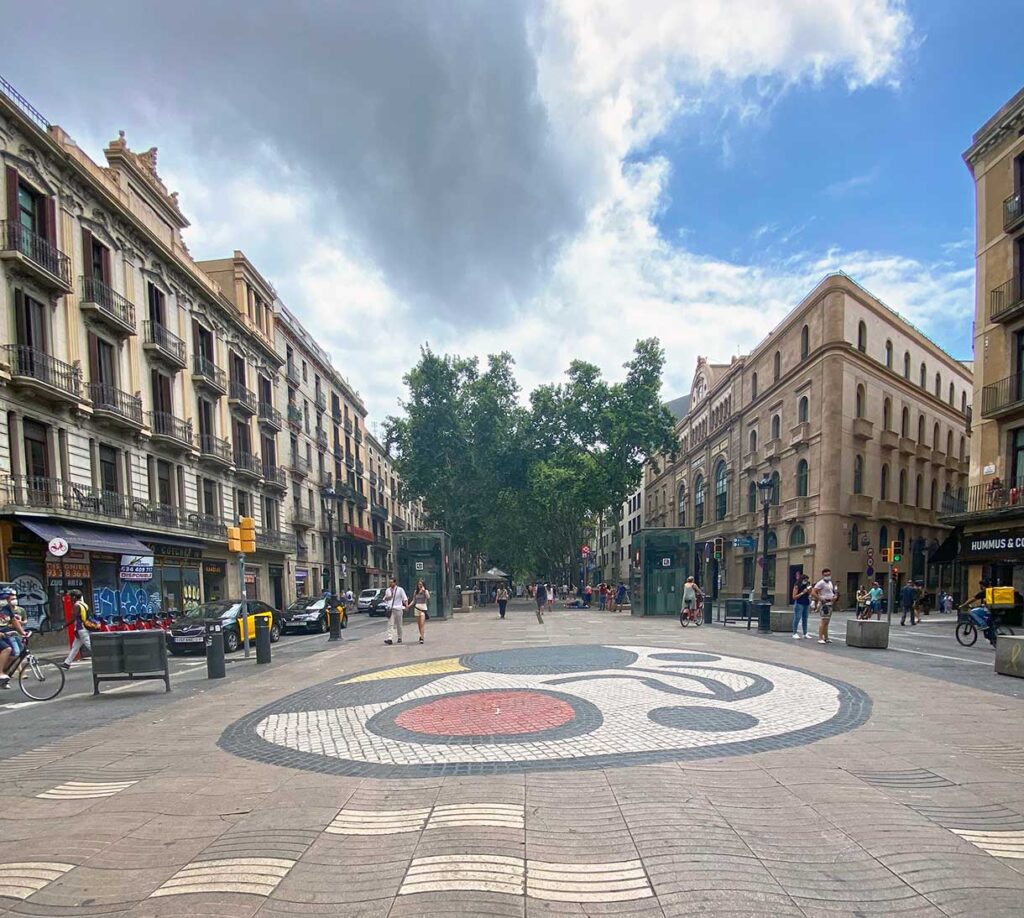
You’ll find this famous pedestrian street in Barcelona referred to as both “La Rambla” and “Las Ramblas”. The official name is the former, so that’s what I’ll use in this guide.
La Rambla runs for about 1.2 kilometers, from Placa de Catalunya to the waterfront. The center of the road is a wide pedestrian promenade lined with flower stalls, cafes, newsagents and street performers. In the middle of the road (distance-wise) you’ll find a colorful mosaic designed by famous Surrealist artist Joan Miro. The mosaic welcomes visitors arriving in the city by sea, and is a complement to the mosaic he designed for the airport to welcome passengers arriving by air.
I recommend skipping any cafes located directly on La Rambla because you’re paying for location, not for the quality of food or drink. I distinctly recall paying €11 for a glass of sangria at a cafe here in 2004, so I can only imagine what prices are today!
As you’re walking down La Rambla towards the water, our first stop is going to about four blocks down the street, on your right…
2. La Boqueria Market
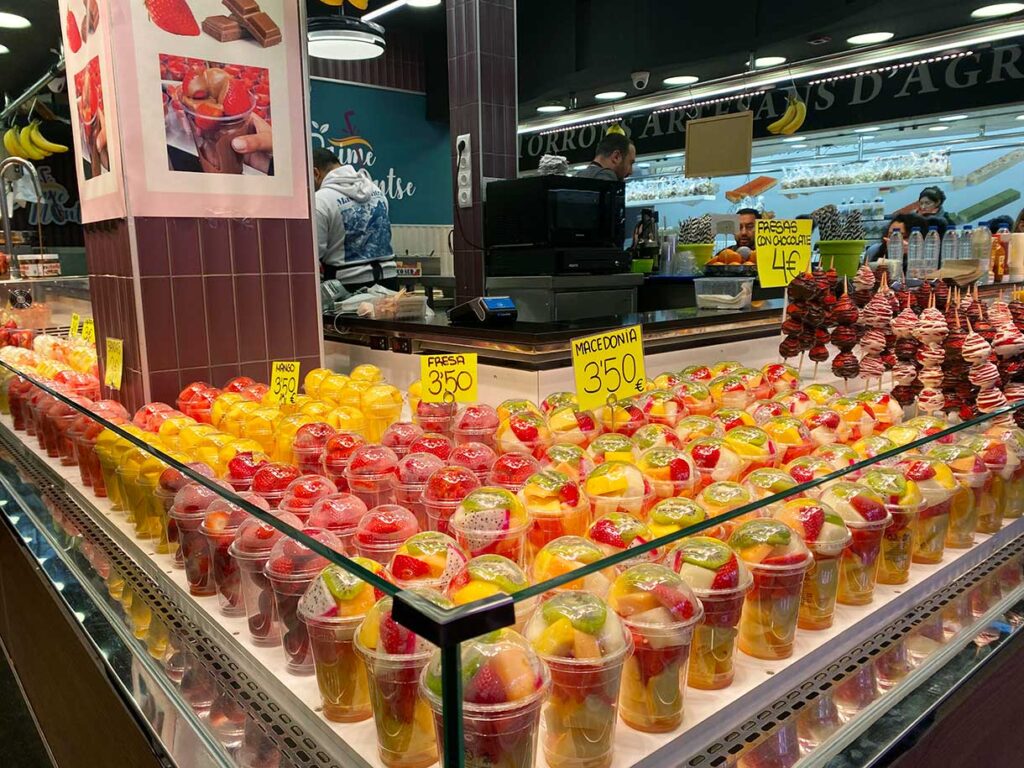
It is believed that a market has stood on this site since the 1200s. Its name likely derives from the Catalan word “boc”, which means “goat”, suggesting that this was the place to buy goat meat in medieval Barcelona. Over the centuries the number of offerings here expanded, and it was in the late 1800s that La Boqueria Market installed its decorative roof and really came into its own.
Today, La Boqueria is a trendy market that caters as much to tourists as to locals. Yes, there are still some fruit, vegetable, fish and dairy vendors, but the majority of the 300+ stalls in the market are now serving up tapas, mixing cocktails and sending tourists on their way with colorful fruit juices and candies.
The earlier in the day you visit the market the more stalls will be open and the more products will be only display, so don’t leave this for later in the day!
3. Basilica de Santa Maria del Pi
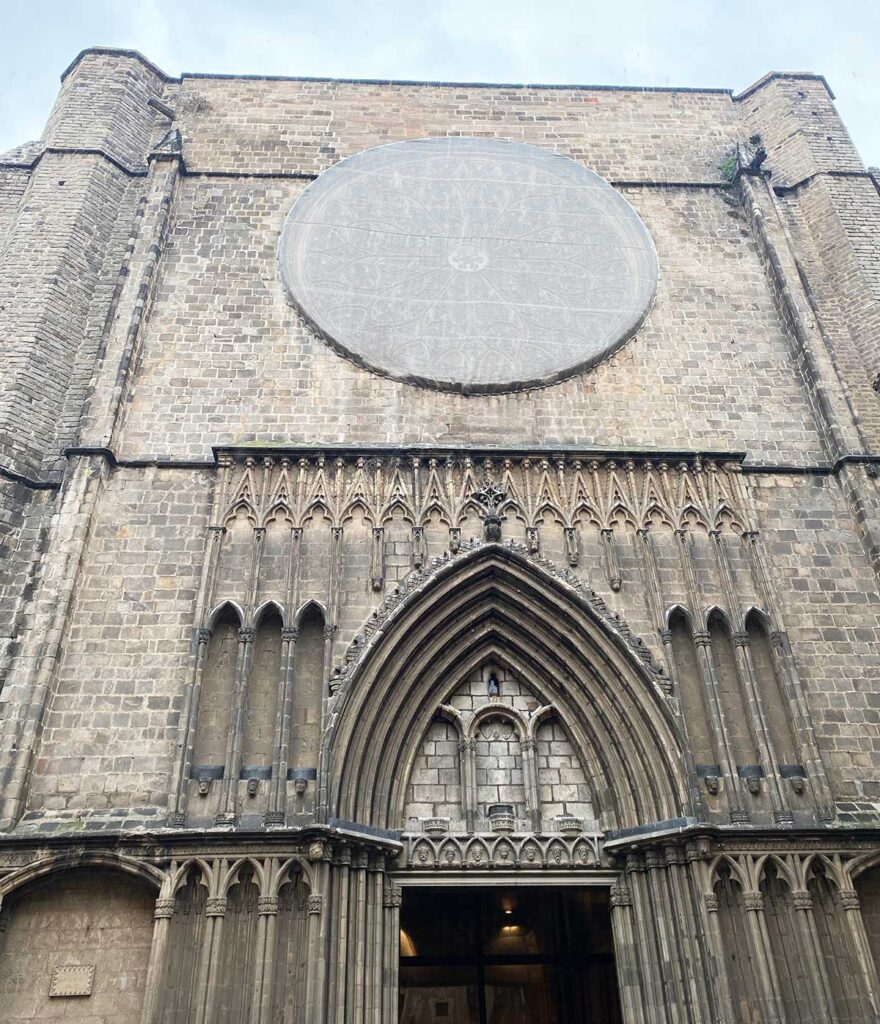
Just five minutes away, on the opposite side of La Rambla, you’ll find Santa Maria del Pi. This 15th-century Gothic church is known for its large rose window on the front facade, which was carefully reconstructed by one of Gaudi’s assistants following the Spanish Civil War.
If you want to enter the church, admission is €8 and includes access to the interior of the church, the crypt, the gardens and the church museum. You may also be able to ascend the 54-meter bell tower, but entry windows are limited (ask before buying your ticket). You should be able to see everything in about 30 minutes.
4. Cathedral of Barcelona

Walk four more minutes in the same direction and you’ll find yourself at the doorstop of a much larger church: The Cathedral of Barcelona. Like Santa Maria del Pi, ticket is needed to enter the church. With only one day in Barcelona I would choose one of the two churches to pay for, but not both.
Admission to the cathedral includes access to the expansive Gothic interior, dating back to the 14th century. However, the real highlight is the ascent (by elevator!) to the rooftop, where you can see the rooftops of the Gothic Quarter and beyond, and examine the bell towers and towering pinnacles from up close. You’ll need a bit more time here, so plan to spend about 45 to 60 minutes inside (including the roof).
5. Plaça de Sant Felip Neri
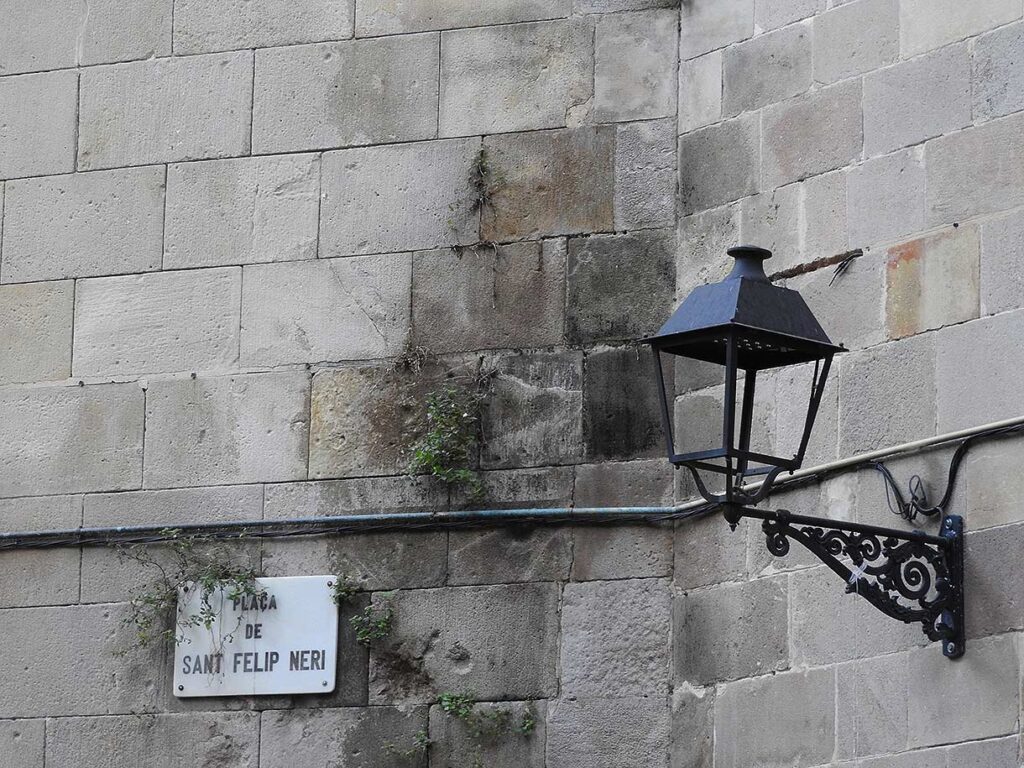
I’m literally getting goosebumps just writing about this tiny plaza in the Barri Gotic. When I imagine a “Gothic Quarter”, this is exactly what comes to mind: antique streetlights, ivy growing down the ancient stone walls, and an old fountain that trickles water like memories. However, the darkest era of Placa de Sant Felip Neri wasn’t in the Gothic era. Rather, it was much more recently.
There is both a church and a school on this plaza, and during the Spanish Civil War Franco dropped a bomb on this spot and thirty children died. Damage from the bomb is still visible on the facade of the church, and a memorial plaque was installed by the city in 2007, both to remind visitors of a dark period in Barcelona’s history.
En route to your next stop, swing by Carrer del Bisbe, or Bishop’s Street. I forgot to take a photo, but this narrow pedestrian throughfare is famous for its ornate, Neo-Gothic bridge connecting two buildings. Although the bridge looks ancient, it was actually built in the 1920s as part of a plan to restore and revitalize the Gothic Quarter, much to the amusement of local residents.
6. Placa de Sant Jaume

If you’re feeling suffocated by the narrow alleys and dark history of the Gothic Quarter, walk a few streets towards the water and you’ll find yourself in the sun-drenched Placa de Sant Jaume, Barcelona’s main administrative square. I swear, every time I walk through this plaza there are either news crews set up ready to hear an announcement from the local government, or some kind of other special event is taking place.
On this square you’ll find the Barcelona City Council building, as well as the Palau de la Generalitat de Catalunya, which is the seat of the Catalonian Government. On the facade of the City Council building you’ll find statues of James the Conquerer, the medieval King of Aragon whose name graces the plaza, and Joan Fiveller, a 14th-century municipal politican. The Palau de la Generalitat de Catalunya is one of the oldest medieval government buildings in Europe that is still in use today.
7. Ancient Roman Temple of Augustus

Before Barcelona there was Barcino, an ancient Roman settlement founded around 15 BCE. They first settled in the spot that is today marked by Placa de Sant Jaume, and within several decades the settlement had expanded throughout today’s Gothic Quarter.
The most prominent landmark that remains from Barcino are the ancient city walls (best viewed one block behind the Jaume I metro station), but the most evocative is the remains of the Temple of Augustus. You’ll find these ruins hidden away in the courtyard of the Barcelona History Museum, visible only to those in the know. The ruins were discovered in the late 1800s and restored several years later. It’s believed that the temple here was originally about 40 meters long, featuring many more columns than stand today.
You can visit the Temple of Augustus in Barcelona for free – and if you’re lucky, you might find that you’re the only people there!
8. Placa del Rei

Another spot that you can check out for free is the Placa del Rei, or the King’s Square. This is the entrance to the former Grand Royal Palaces (shown above), where the royal families of the Kingdom of Aragon lived during the early Spanish Renaissance.
It’s possible to buy a combined ticket that includes admission to the Royal Palaces (not full of stately decor, but rather of excavated Roman ruins) and the adjacent Barcelona Museum of History, but with only one day in Barcelona I would recommend just visiting the courtyard.
The next stop on this walking tour is back towards Las Ramblas, about midway between where you are and the sea. The fast way to get there is to double back along Carrer de Jaume I, the busy street that crosses all of the Barri Gotic, and then turn left towards the sea. The scenic route to get there is to cross Carrer de Jaume 1 and wander back through whichever narrow Gothic streets capture your imagination.
9. Placa Reial
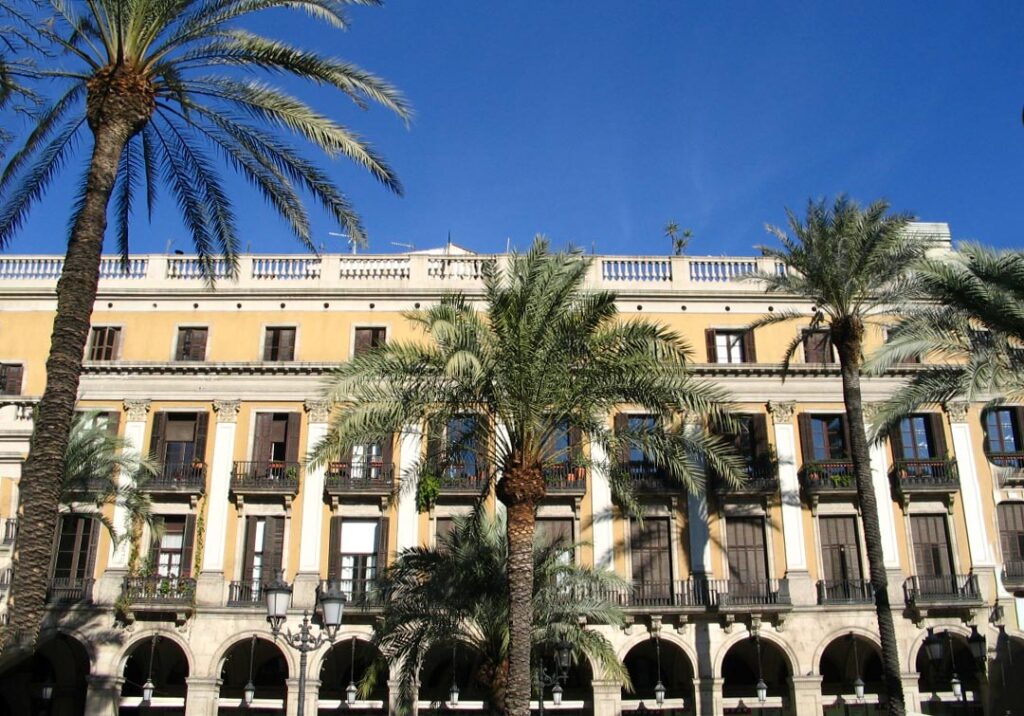
On my first trip to Barcelona (all the way back in 2004!) this was the spot that captured my heart and my imagination. In fact, the photo above is from that trip! I have newer photos, but there was something about that winter day, with a bright blue sky and the sunny yellow facades, that remains etched in my memory twenty years later.
Placa Reial translates to “Royal Plaza”, but its name comes not from a connection to royalty, but simply from being so beautiful. Landmarks here include the central fountain (a popular meeting spot for young people heading out for a night on the town), two streetlights designed by none other than Gaudí himself, and iconic palm trees. The covered archways surrounding the plaza are lined with restaurants, cafes and bars. Some are overpriced but others (especially Les 15 Nits) are a good value – just check the prices on the menu carefully before ordering any food or drink.
10. Christopher Columbus Monument
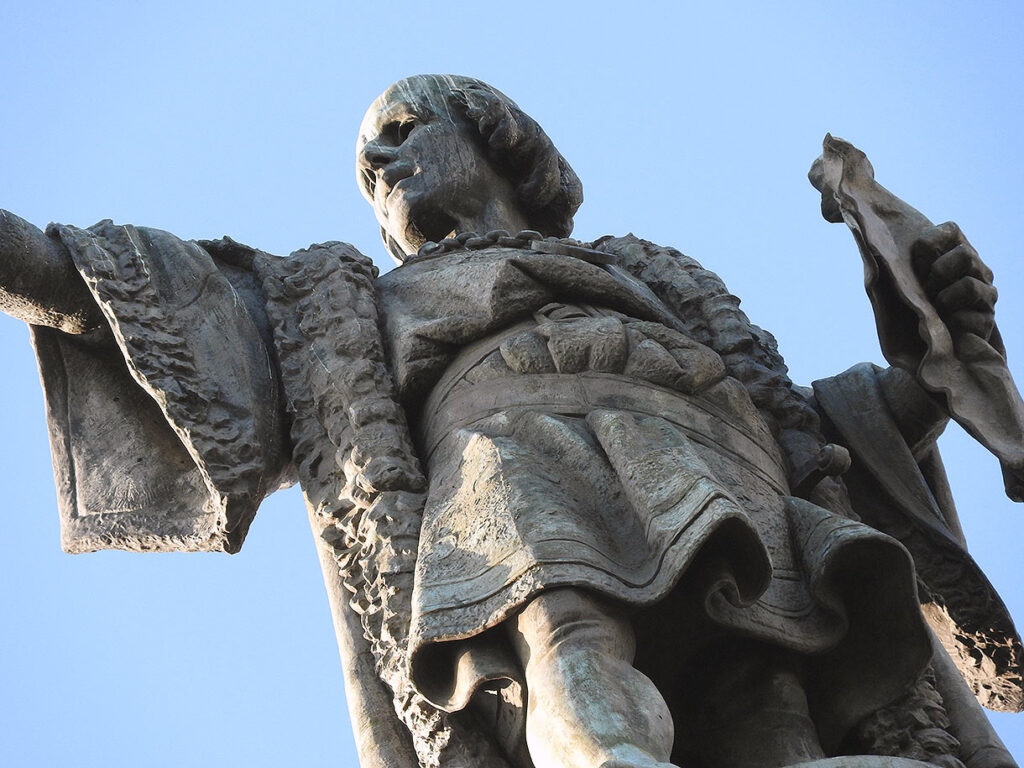
From Placa Reial it’s a short walk along the last stretch of La Rambla to the final stop on your walking tour: the monument to Christopher Columbus.
Standing 60 meters (almost 200 feet) tall, this landmark tower marks the (approximate) spot where Columbus disembarked on his return from the Americas, which had been funded by Spanish royals Isabella and Ferdinand. The monument was constructed for the 1888 Word Exposition, and also features homages to four continents (Europe, Asia, Africa and the Americas), the various kingdoms of Spain and important figures in the Catalan Age of Discovery.
You can take an elevator to the top of the monument, but if you’ve already gone up Sagrada Familia or one of the churches in the Gothic Quarter then this won’t offer any views you haven’t already seen.
4:00 – Rambla de Mar & Scenic Bus Ride
Cross the street behind the Columbus Monument to find Rambla de Mar, an overwater extension of La Rambla. The wooden bridge will take you to the Maremagnum shopping center (not my favorite) and the Aquarium of Barcelona, but you’re just here for the fresh sea air and the bus stop, #1483 Port Vell, where you can catch Bus #V17 for a thirty-minute ride to your next stop: Passeig de Gracia. Tap your credit card on the machine as you board to pay for your bus ticket.
On the way to Passeig de Gracia the bus will pass by Parc de la Ciutadella, and you’ll have a view of the Arc de Triomf out the right-hand side of the bus. Stay on the bus until it crosses Passeig de la Gracia, and get off at the first stop. From here, it’s an easy downhill walk along Barcelona’s most elegant corridor to see even more of Gaudi’s famous buildings.
(The bus stop here is also an easy walk to Paral·lelo Gelato, a popular new gelateria with homemade flavors like matcha, lemon ginger and coconut-caramel with sea salt. 😉)
If you don’t want to take the bus you can also make the trip by taxi or Uber. However, they might not follow the same scenic route as the bus.
Before you start walking down Passeig de Gracia, I recommend backtracking along Avenida Diagonal for three blocks, as this will showcase two beautiful, but slightly-less-famous, Barcelona landmarks. Immediately, you’ll see the wavy windows of Casa Comalat (designed by Salvador Valeri i Pupurull, who was inspired by Gaudi). After three blocks, you’ll spot the red towers of Casa de las Punxes (designed by Josep Puig i Cadafalch, who also designed the building where Els 4 Gats is located – see the lunch section above).
4:45 – Passeig de La Gracia
If you’re in Barcelona in the winter it may be approaching sunset by now, but have no fear: Passeig de Gracia is equally beautiful by day or by night. This wide street is just over one kilometer in length, connecting the Gracia neighborhood at its upper end with Placa de Catalunya at its lower end. Along both sides of the street you’ll find luxury apartments, high-end boutiques and more of Barcelona’s most architecturally-significant buildings.
Casa Mila
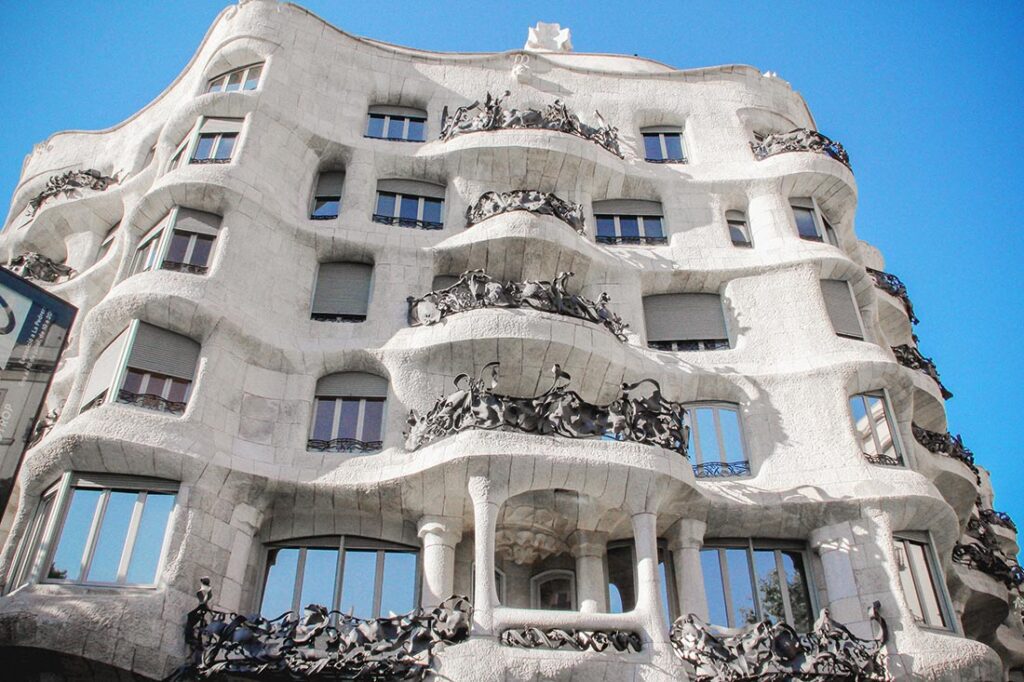
The first monument you’ll encounter on Passeig de Gracia is Gaudi’s Casa Mila, also known as La Pedrera. You could go inside (make sure to book tickets online well in advance) but I always thought that the bright white facade of this building was more striking than the interior. With only one day in Barcelona I suggest viewing Casa Mila from outside, though the pretty rooftop is definitely worth visiting if you have more time in the city.
On the same side of the street as Casa Mila, at the corner of Carrer de Valencia, you’ll find Casa Vidua Marfa, which is famous for its stained-glass windows and arched carriage entrances.
Block of Discord
From Casa Vidua Marfa, walk one more block towards the water to reach one of the most famous city blocks on the planet: the Illa de la Discòrdia, or the Block of Discord. Here, four incongruent Modernist buildings, each designed by a different architect, compete for the attention of passers-by.
The Wikipedia article for this block has an excellent photo that shows the layout of the block, including the year each building was constructed and the architect responsible for it.
Casa Battlo

Gaudi’s other famous building on Passeig de Gracia is the beautifully-tiled Casa Battlo. I always thought its exterior was less memorable than Casa Mila, but of the two buildings I preferred the interior visit here. The sheer amount of mosaic tile work is amazing, and the arched loft area epitomizes minimalistic elegance.
Again, though, with only one day in Barcelona I would probably just admire Casa Battlo from outside. If you want to go inside, book tickets online well in advance through the official site.
Casa Amatller
I have never actually gone inside this building, which is the one with the jigsaw-like roof beside Casa Battlo. The interior has been converted to a “house museum”, where you can take a guided tour to learn about the Amatller family who commissioned the building, the architect (Puig i Cadafalch, see above) and the Catalan Modernist style that makes this street so unique.
6:30 – Flamenco Show

You’ve been walking all day, so why not rest your feet and experience some authentic Spanish culture?
Barcelona’s City Hall Theater puts on early-evening flamenco shows in an original 19th-century theatre. Their location is super-convenient (right at the end of Passeig de Gracia) and your ticket includes guaranteed seating for the one-hour performance. If you haven’t had a glass of sangria or cava yet, you can also choose the tickets that include a beverage.
If you’re hungry now and want to come back to watch the show later, there are also performances later in the evening (at publication time, including at 8:30 pm and 10:00 pm).
8:00 – Dinner

In Spain, 8:00 is considered early for dinner, but by this time most of the city’s restaurants should be opening their doors. There are quite a few options near the City Hall Theater, or you could stroll over to El Born, which is considered to be Barcelona’s culinary district. In addition to the lunch restaurants I mentioned above, some good dinner options include:
- Bormuth – I had some excellent tapas at this cozy restaurant in El Born, including breaded eggplant with honey (shown above) that I still think about far too often.
- Les 15 Nits – This budget-friendly restaurant in Placa Reial is a bit touristy, but half the fun is being entertained by the buskers as you queue in the square to enter. They can accommodate dietary restrictions with a set three-course menu for vegans and a separate kids menu too.
- 100 Montaditos (Placa d’Urquinaona location) – A “montadito” is a small sandwich, and this inexpensive fast-food restaurant chain has 100+ of them on their menu. Combine a few with a side dish to make a quick, light dinner.
10:00 – Back to Your Hotel
I have an entire guide to the best neighborhoods to stay in Barcelona, but with only one day I would limit my accommodation search to properties in the Barri Gotic. This is the most central area of Barcelona and the best for sightseeing by foot and public transportation. At the link I recommend these central hotels:
- Hotel Colon – For years, savvy travelers have been checking into this surprisingly-affordable hotel located across the square from the Cathedral of Barcelona.
- Hotel Catalonia Avinyo – It doesn’t get much more convenient than this hotel, located midway between the Liceu and Jaume I metro station in the Barri Gotic. From this modern, comfortable hotel it’s easy to get anywhere in the city.
- The Moods Cathedral Hostal Boutique – Situated on a placa that backs onto the Cathedral walls, this hostal (which translates to “independent hotel”, not “hostel) has a complimentary coffee bar, and many rooms have private balconies where you can sip that coffee with a view!
Or you can just open the map on this page to see what hotels in the Barri Gotic are available and within your price range for your short visit to Barcelona.
![]()
Have you been to Barcelona? If you were going back and only had one day, what you visit and why? Let me know in the comments!
Staying longer? Check out all of my favorite things to do in Barcelona, my favorite areas to stay in Barcelona, and my recommended day trip to Girona!
![]()
Planning a trip? Pin this post for later!
 |
 |
